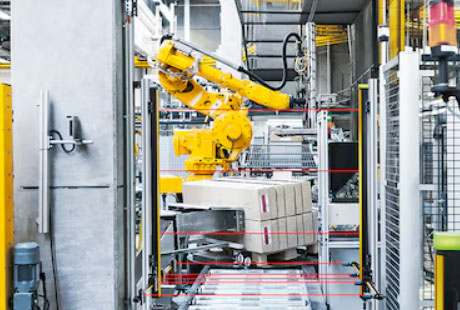How Does A Safety Light Curtain Sensor Work?
Key Takeaway
A safety light curtain sensor operates by transmitting an invisible light across a designated area. This system has two main components: a transmitter, which emits the light, and a receiver, which detects the light. When the light beam is interrupted—by a person, object, or part of machinery—the receiver no longer detects the signal and triggers an emergency stop (E-Stop).
This safety mechanism ensures that any movement or operation posing potential harm is halted immediately, thus preventing accidents and enhancing workplace safety. The system is crucial in environments where physical barriers are impractical, providing a responsive and reliable safety solution.
Overview of Safety Light Curtain Sensors
Safety light curtain sensors play a pivotal role in automated and industrial environments by providing a protective barrier that doesn’t impede the productivity of machinery. Unlike physical barriers, these systems allow for the efficient and safe operation of equipment, ensuring that any interruption by an unauthorized object instantly halts operation. This technology is particularly crucial in areas where personnel might frequently interact with automated processes, providing a balance between safety and operational efficiency.

The Basic Mechanics of Light Curtain Sensors
Light curtain sensors operate through a straightforward yet robust mechanism. They consist of a pair of devices: one emitter and one receiver. The emitter sends out beams of light, usually infrared, which are picked up by the receiver across the protected area. When any of the beams are blocked, by a person or object, the receiver detects this interruption and sends a stop signal to the machine’s control system. This rapid response helps to prevent potential injuries or damage by stopping the machine immediately.
Key Components of Light Curtain Sensors
The functionality of light curtain sensors relies heavily on their three main components. The emitter generates a constant stream of light beams. The receiver, positioned opposite the emitter, monitors these beams and detects any interruptions. The control unit processes the information from the receiver and executes a response, such as halting the machinery. Advanced models may include additional features like muting capabilities, which allow temporary suspension of the safety function under controlled conditions, enhancing flexibility without compromising safety.
Step-by-Step Operation of a Light Curtain Sensor
The operational process of a light curtain sensor begins when the emitter sends out a beam that is received by the detector. Should this beam be interrupted, the detector signals this change to the control unit. The control unit then assesses the signal and, if it confirms a legitimate interruption as opposed to a system error, it activates the machine’s emergency protocols. This often includes stopping the machine immediately to prevent access to the hazardous area, ensuring the safety of personnel and equipment alike.
Integration with Other Safety Systems
Integrating light curtain sensors with other safety systems enhances their effectiveness. For instance, they can be linked with emergency stop buttons, safety interlocks, and alarms to create a comprehensive safety network. This integration allows for coordinated responses to various potential hazards, offering layered protection. By connecting these systems, facilities can ensure a safer environment that complies with international safety standards, such as ISO 13849 and IEC 62061.
Conclusion
Light curtain sensors are indispensable in the modern industrial landscape, where safety and productivity must coexist seamlessly. By understanding and utilizing these systems, industries can protect their workers from potential hazards associated with high-speed machinery and robotic operations. The adoption of light curtain sensors not only fulfills legal safety obligations but also fosters a culture of safety and vigilance, which is crucial for maintaining high morale and productivity in any industrial setting.
